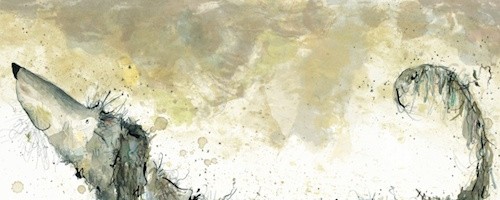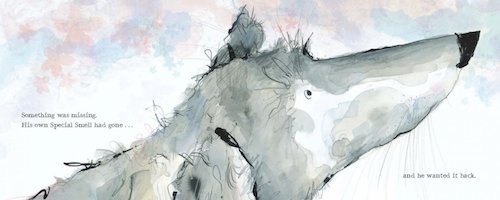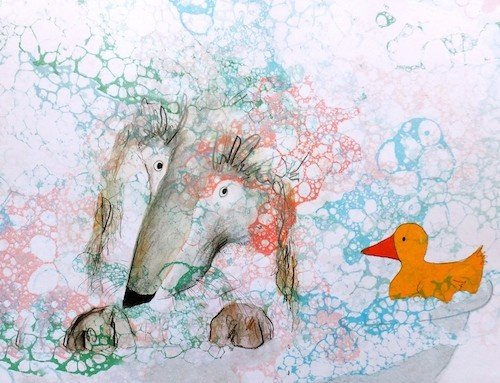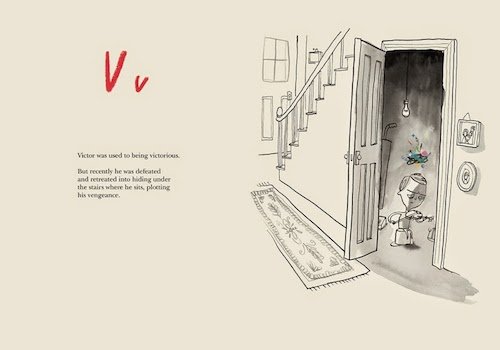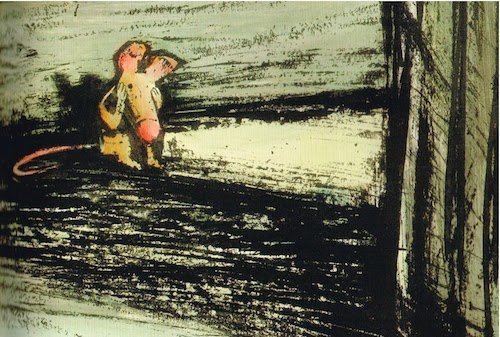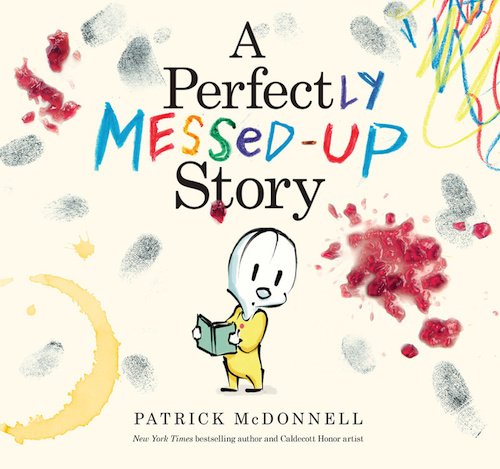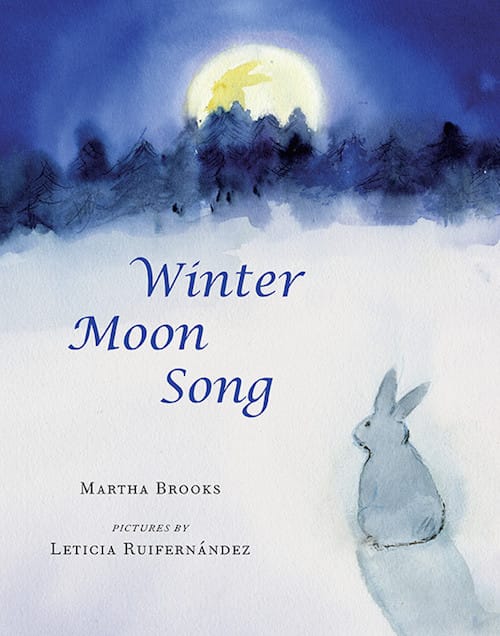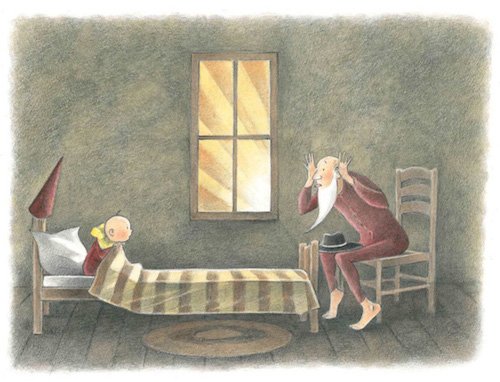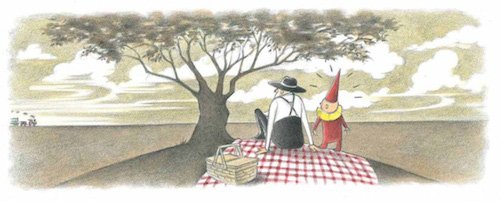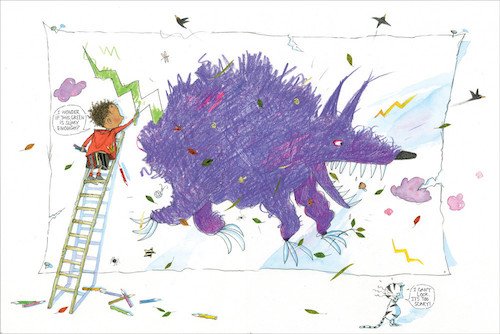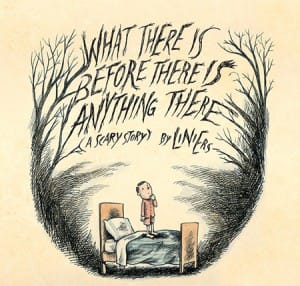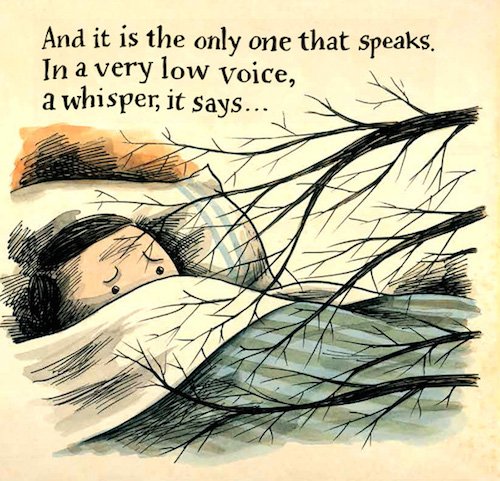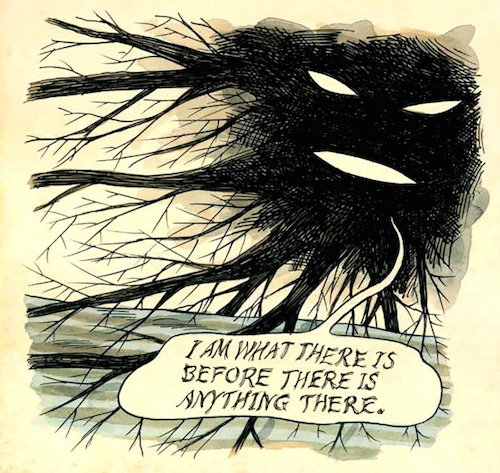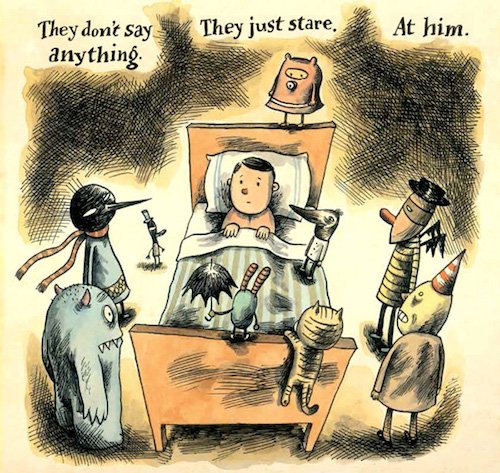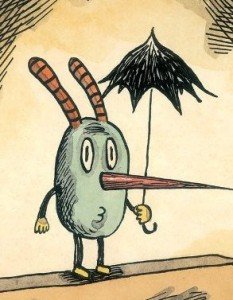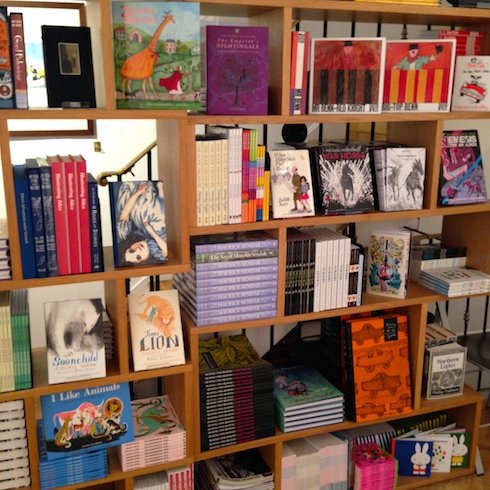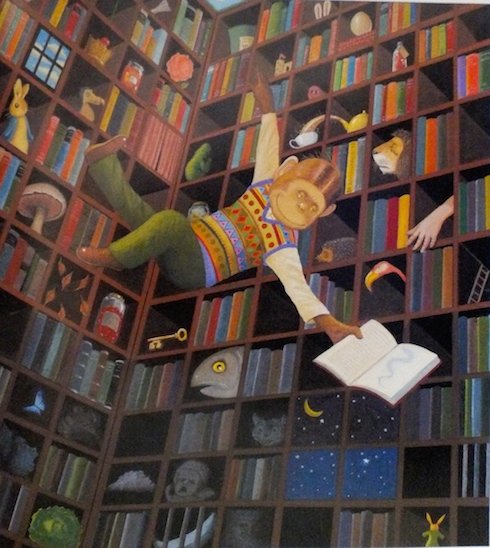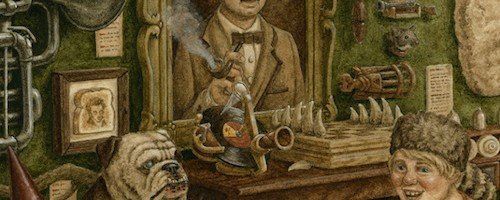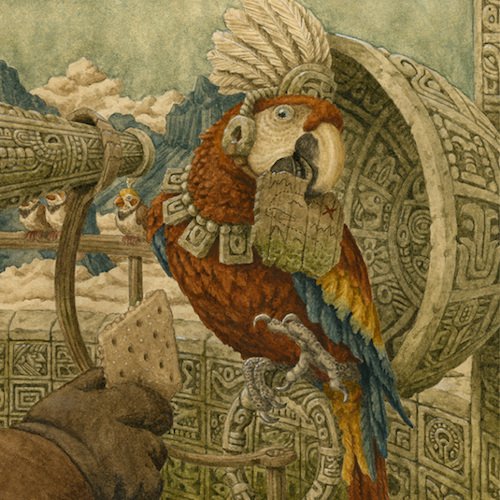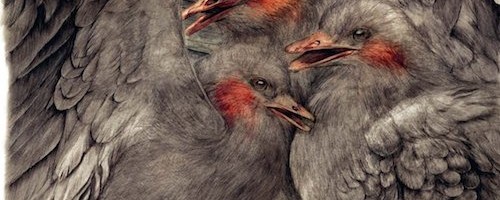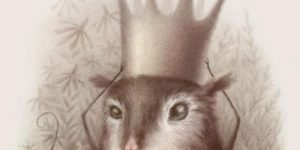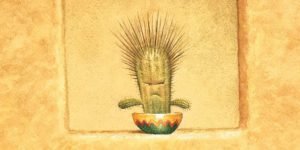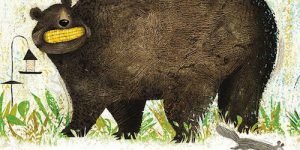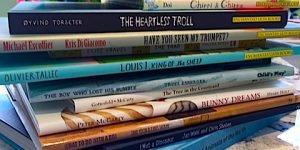Funny…I honestly expected to have few, if any, books for my next Shelf Landings post. And where did they come from anyway? It’s a familiar feeling – the one where I think I can’t possibly be gobsmacked by one more book. Surely the well of creativity and invention has been sucked dry. Nope. That well is infinite. (Too bad my pockets aren’t as deep.) Nevertheless, it was and IS my intention to make Shelf Landings brief and frequent, a quick post whenever a new book wanders into my life, but as the kids say, #epicfail. Ah well, I tried. Here are the books that have smacked me in the gob this last month.
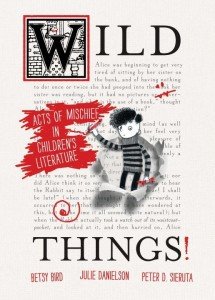 Wild Things! Acts of Mischief in Children’s Literature (Candlewick Press, 2014) arrived a week ago, and it looks…delicious. Written by fellow bloggers Julie Danielson, Betsy Bird, and the late Peter Sieruta, the book “offers untold (and often very amusing) stories behind many beloved children’s books and their creators and is a bracing antidote to the sentimentality that often surrounds the genre.” Oh wow! I couldn’t be more excited. As a former bookseller and life-long collector of children’s books, I am frustrated by the “fluffy bunny” dreck served to children on a daily basis, but like these three authors, I am also uplifted by the beauty and intelligence of a well-crafted children’s book. Wild Things promises to be an elucidating and wickedly fun read.
Wild Things! Acts of Mischief in Children’s Literature (Candlewick Press, 2014) arrived a week ago, and it looks…delicious. Written by fellow bloggers Julie Danielson, Betsy Bird, and the late Peter Sieruta, the book “offers untold (and often very amusing) stories behind many beloved children’s books and their creators and is a bracing antidote to the sentimentality that often surrounds the genre.” Oh wow! I couldn’t be more excited. As a former bookseller and life-long collector of children’s books, I am frustrated by the “fluffy bunny” dreck served to children on a daily basis, but like these three authors, I am also uplifted by the beauty and intelligence of a well-crafted children’s book. Wild Things promises to be an elucidating and wickedly fun read.

Newly published this month, The Slug and The Rat (Tundra Books, 2014) join their ‘Disgusting Critters’ brethren, The Fly and The Worm in this crazy wonderful series by Elise Gravel. I cannot say enough about this Canadian author/illustrator, and her funny, gorgeously illustrated, and yes, educational books. I plan to get down and dirty with these disgusting critters and write a longer review at a later date, but for now, I will leave you with the covers. Gotta admit though…I have a hard time finding rats or even slugs disgusting, especially when Gravel makes them so darned affable.
 God Got a Dog (Beach Lane, 2013) is the just the sweetest collection of poetically arranged prose and exquisite art! I bought in on the spot when I saw the word ‘dog’ and the name ‘Marla Frazee.’ (And of course, author Cynthia Rylant is no slouch.) God Got a Dog is a dreamy, beautiful book that belongs in everyone’s library. Each page is an ode to some ordinary aspect of human life, like taking a bath, or…getting arrested. I am particularly fond of ‘God Woke Up’, where God is seen sitting under an apple tree in his pajamas, drinking coffee, quietly pondering the beauty around him –
God Got a Dog (Beach Lane, 2013) is the just the sweetest collection of poetically arranged prose and exquisite art! I bought in on the spot when I saw the word ‘dog’ and the name ‘Marla Frazee.’ (And of course, author Cynthia Rylant is no slouch.) God Got a Dog is a dreamy, beautiful book that belongs in everyone’s library. Each page is an ode to some ordinary aspect of human life, like taking a bath, or…getting arrested. I am particularly fond of ‘God Woke Up’, where God is seen sitting under an apple tree in his pajamas, drinking coffee, quietly pondering the beauty around him –
“The birds were singing and He was at peace. Buddha told Him it could be this way, but He’d never really believed it until now. Life really was easier, sitting under a tree.”
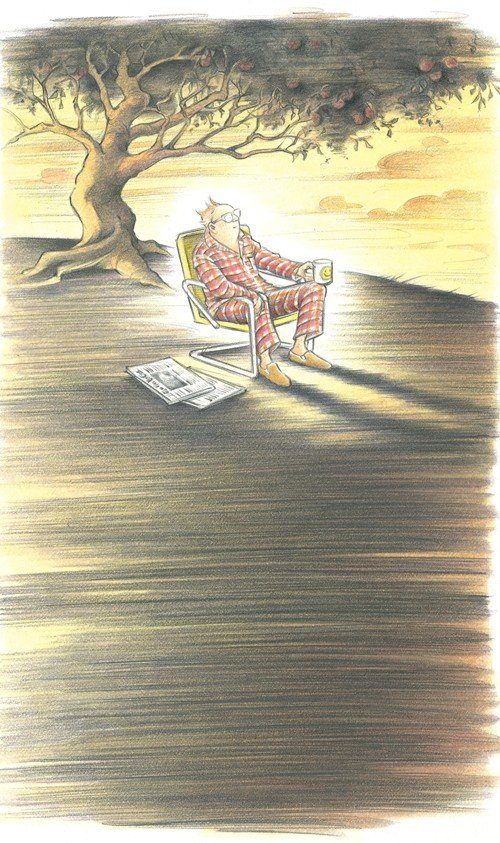
I am a HUGE fan of Marla Frazee’s illustration and cannot imagine a lovelier compliment to her art than the charming, evocative words of Cynthia Rylant. Protagonist notwithstanding, God Got a Dog is reverent, but not overtly religious. Most wonderfully, God is imagined as a man and as a woman, old, young, white, black, and as a lover of dogs. In pondering what it is to be human, imperfections and all, God Got a Dog is itself, a rare, perfect creation.
 I have a fascination with the American Civil War. No surprise, as I am a white Canadian of the female persuasion. Seriously, I have no idea where this comes from, but I suspect it has something to do with Ken Burns and an early reading of Russell Banks’ Cloudsplitter, a superb novel about abolitionist John Brown. Incidentally, I recently finished the fabulous The Good Lord Bird by James McBride, which is also about Brown’s sordid activities preceding (and precipitating) the Civil War, but written from the point of view of a young black boy.
I have a fascination with the American Civil War. No surprise, as I am a white Canadian of the female persuasion. Seriously, I have no idea where this comes from, but I suspect it has something to do with Ken Burns and an early reading of Russell Banks’ Cloudsplitter, a superb novel about abolitionist John Brown. Incidentally, I recently finished the fabulous The Good Lord Bird by James McBride, which is also about Brown’s sordid activities preceding (and precipitating) the Civil War, but written from the point of view of a young black boy.
There is no shortage of books about the Civil War and the history of slavery in the United States, and more than a few of these are written for children. One day I will do an overview of these books, but for now, I was pleased to find Henry’s Freedom Box: A True Story from the Underground Railroad (Scholastic Press) on the shelves of my local bookstore while I was still reading The Good Lord Bird. The picture book has been around since 2007, becoming a Caldecott Honor book the following year. No wonder – it’s beautiful. Ellen Levine’s biographical narrative of Henry Brown’s life from a young age (slaves were not allowed to know their birthdays) to adulthood is both inspiring and heartbreaking. Henry Brown was born a slave in Virginia, but later, when his own family is sold, he arranges his freedom by having himself mailed to awaiting abolitionist activists in Philadelphia, via the Underground Railroad. It is harrowing, but in Levine’s hands, it also reads like an adventure story (with a happyish ending.)


I love Kadir Nelson’s illustration on the cover depicting a young Henry ‘Box’ Brown, at that point still a slave, staring intently at the viewer. In this illustration especially, Nelson truly captures the self-possession and determination Brown must have possessed to embark on such a desperate, dangerous journey. Inspired by a lithograph of Henry ‘Box’ Brown by Samuel Rowse (created as a fundraiser in 1850 for the anti-slavery movement), Nelson uses crosshatched pencil lines, with applications of watercolour and oil to achieve the original feel of the lithograph. The illustrations are stunning, and like Levine’s words, deeply intimate.
Not a day goes by when I am often lurking about the Brain Pickings blog, which is a good place to feed your book lust, if you have one. Back in April I  read a post about John Vernon Lord, a British illustrator, and his illustrations for a special edition of Through the Looking-Glass. I love pen & ink illustration, having dabbled in it myself, and his work just BLEW MY MIND. A copy of Through the Looking-Glass proved too hard to find, and too expensive, so I ordered a copy of Drawn to Drawing: John Vernon Lord (Nobrow Press, 2014), a newly published, visual biography of his creative output over the last 50 years. It’s splendid! Makes me want to unpack my pens…so I can stab myself in the neck with them. I mean, why bother?
read a post about John Vernon Lord, a British illustrator, and his illustrations for a special edition of Through the Looking-Glass. I love pen & ink illustration, having dabbled in it myself, and his work just BLEW MY MIND. A copy of Through the Looking-Glass proved too hard to find, and too expensive, so I ordered a copy of Drawn to Drawing: John Vernon Lord (Nobrow Press, 2014), a newly published, visual biography of his creative output over the last 50 years. It’s splendid! Makes me want to unpack my pens…so I can stab myself in the neck with them. I mean, why bother?
 A longer review of Homer Henry Hudson’s Curio Museum (Creative Editions, 2014) by Zack Rock will follow, but I cannot resist posting a small teaser. Incredibly, this is Rock’s first picture book, but it is, like one of the curio objects in Homer Henry Hudson’s museum, a treasure; revelatory, full of quirk, and exquisitely beautiful. That Homer Henry Hudson just happens to be a bulldog is but one of the many delightful oddities to be found within the pages of this book. Can’t wait to dive in paws first.
A longer review of Homer Henry Hudson’s Curio Museum (Creative Editions, 2014) by Zack Rock will follow, but I cannot resist posting a small teaser. Incredibly, this is Rock’s first picture book, but it is, like one of the curio objects in Homer Henry Hudson’s museum, a treasure; revelatory, full of quirk, and exquisitely beautiful. That Homer Henry Hudson just happens to be a bulldog is but one of the many delightful oddities to be found within the pages of this book. Can’t wait to dive in paws first.
A book like The Forever Flowers (Creative Editions, 2014) elicits two responses: the first, damn. The second, double damn.  Michael J Rosen and Sonja Danowski have created something very special with The Forever Flowers. A young grouse clings to summer, as manifested in the petals of a forever flower – the first to appear, the last to disappear – which she keeps in a small packet around her neck. The extra weight draws her down to a pond, and she misses the migration. Taken in by a kindly spaniel and his companion, the bird impatiently awaits the return of spring. There is more to it, much more, but I will reserve my thoughts until I can write a fuller review. But for now…damn.
Michael J Rosen and Sonja Danowski have created something very special with The Forever Flowers. A young grouse clings to summer, as manifested in the petals of a forever flower – the first to appear, the last to disappear – which she keeps in a small packet around her neck. The extra weight draws her down to a pond, and she misses the migration. Taken in by a kindly spaniel and his companion, the bird impatiently awaits the return of spring. There is more to it, much more, but I will reserve my thoughts until I can write a fuller review. But for now…damn.
 I’ve just finished re-reading To Kill a Mockingbird, and was struck anew by the brilliance of the story, and by extension – Harper Lee. I am very much looking forward to reading The Mockingbird Next Door: Life With Harper Lee (The Penguin Press, 2014), a new biography of sorts, written by Marja Mills. In some metaphysical twist of fate, Mills was given Lees’ blessing to move next door to the notoriously media shy author (who lives with her sister Alice Finch Lee), and was, over the span of several years, privy to the daily minutiae of Ms. Lee’s life. A timely publication, as I am not yet ready to leave Maycomb.
I’ve just finished re-reading To Kill a Mockingbird, and was struck anew by the brilliance of the story, and by extension – Harper Lee. I am very much looking forward to reading The Mockingbird Next Door: Life With Harper Lee (The Penguin Press, 2014), a new biography of sorts, written by Marja Mills. In some metaphysical twist of fate, Mills was given Lees’ blessing to move next door to the notoriously media shy author (who lives with her sister Alice Finch Lee), and was, over the span of several years, privy to the daily minutiae of Ms. Lee’s life. A timely publication, as I am not yet ready to leave Maycomb.
Lastly, I picked up Krazy Kat & The Art of George Herriman (Craig Yoe, Abrams, 2011) because I have immense respect for the history of comic art, and I  wanted to read the the essay by Bill Watterson. I’m not sure if this constitutes a good enough reason to purchase the book, especially as I am only peripherally aware of George Herriman via my other cartoonist obsessions (McDonnell, Watterson, etc.,), but, as it turns out, Krazy Kat is as lovely as it is interesting. Most definitely a book to be lingered over.
wanted to read the the essay by Bill Watterson. I’m not sure if this constitutes a good enough reason to purchase the book, especially as I am only peripherally aware of George Herriman via my other cartoonist obsessions (McDonnell, Watterson, etc.,), but, as it turns out, Krazy Kat is as lovely as it is interesting. Most definitely a book to be lingered over.
That’s it! For now. Stay tuned…
 Louie gets progressively dirtier as he explores the neighbourhood, seeking help from the various creatures he encounters. Wiggling in ‘wonderfully whiffy’ sludge and ‘pongy ponds’, Louie layers smell after smell like a true stink connoisseur until he finally achieves his own personal nirvana – his Special Smell. Rayner does a magnificent job visualizing Louie’s befouled, fly-ridden fur. In squibbles, splotches, and tangled strokes of watercolour and inks of varying widths and dirt tones, Louie’s coat comes alive with scent. Somehow, he is still beautiful, and the book itself is one of Rayner’s loveliest, and funniest outings. Perhaps it’s the joy Louie radiates as he returns home, proud and unrepentant, a haze of stench in his wake. Sadly, as Louie discovers shortly after entering the house, non-canines rarely appreciate the complexity or skill involved in the creation of a Special Smell. Sorry pal, we just don’t have the snout for it.
Louie gets progressively dirtier as he explores the neighbourhood, seeking help from the various creatures he encounters. Wiggling in ‘wonderfully whiffy’ sludge and ‘pongy ponds’, Louie layers smell after smell like a true stink connoisseur until he finally achieves his own personal nirvana – his Special Smell. Rayner does a magnificent job visualizing Louie’s befouled, fly-ridden fur. In squibbles, splotches, and tangled strokes of watercolour and inks of varying widths and dirt tones, Louie’s coat comes alive with scent. Somehow, he is still beautiful, and the book itself is one of Rayner’s loveliest, and funniest outings. Perhaps it’s the joy Louie radiates as he returns home, proud and unrepentant, a haze of stench in his wake. Sadly, as Louie discovers shortly after entering the house, non-canines rarely appreciate the complexity or skill involved in the creation of a Special Smell. Sorry pal, we just don’t have the snout for it.
